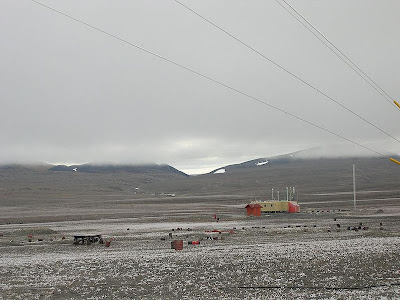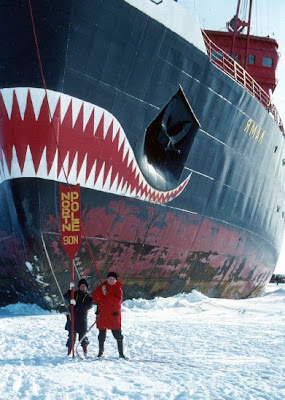 |
| A really old map of the North Pole, made by Gerardus Mercator in 1595 |
Anyway, if you were standing on the exact site of the North Pole, any direction you went from there would be south. The North Pole is also called the Geographic North Pole, and it is at the latitude of 90º North. This is also called true north, and it is exactly opposite the South Pole. The Geographic North Pole is different from the Magnetic North Pole because the Magnetic North Pole is not true north. Instead, it is based on the magnetosphere of the Earth, and it is always moving around.
Both the North Pole and the South Pole have a bunch of ice on top of them, but the South Pole is located in Antarctica, and the North Pole is in a frozen ocean. So even if you set up a pole at the North Pole, the ice where you put the pole would move around some, and then your pole would be in the wrong place. The ice at the North Pole is about 7 to 10 feet thick, and the sea at the Pole is 13,930 feet deep. The closest land to the North Pole is Kaffeklubben Island, which is off the northern coast of Greenland, about 430 miles away. But nobody lives there.
 |
| The town of Alert |
The closest place where any people actually live is a town called Alert, in the Qikiqtaaluk Region of Nunavut, Canada. This town is located 508 miles from the Pole. Alert was named for the HMS Alert, which was a British ship that wintered near there in 1875-76. The permanent population of Alert might be as many as 10 people, but there are other people who just stay there part of the time. In Alert there is a weather station and also a military intelligence station. I don't know if any dogs live in Alert, but if they do, I hope they have really thick fur coats!
Starting way back in history, people wanted to go to the North Pole. I don't know why, except maybe just because it was there. Some sailors tried getting there in ships, but mostly they got stuck in the ice, and some of them died. Other people tried to go there with dog sleds.
 |
| The Peary Expedition |
On April 6, 1909, a U.S. Navy engineer named Robert Peary said he and Matthew Henson reached the Pole, along with four Inuit men. They took a picture of themselves when they got there, but they did not include their sled dogs in the picture, which doesn't seem fair, if you ask me. Anyway, since nobody on the trip was really trained in navigation, some people said later that Peary did not find the right spot where the Pole was.
The first flight over the Pole was made on May 9, 1926 by Richard E. Byrd and Floyd Bennett, but later it turned out that their solar sextant wasn't very accurate, or something like that. So they probably didn't really get to the Pole either.
On May 12, 1926, a Norwegian explorer named Roald Amundsen flew from Norway to Alaska in the airship Norge. This trip had accurate proof that it really crossed over the Pole. After that, the first people to walk on the Pole, and to be in the right place when they did it, was a group from the Soviet Union who landed a plane there on April 23, 1948.
 |
| USS Skate |
The first submarine to cross the North Pole was the USS Nautilus, on August 3, 1958. Then on March 17, 1959, the USS Skate surfaced at the Pole, which made it the first naval vessel to do that.
If you had to live at the North Pole or the South Pole, you should choose the North Pole because it's at sea level, and that makes it warmer there. Which may be why Santa lives at the North Pole. In January, the temperature ranges from --45ºF to --15ºF. In the summer, temperatures average about freezing. The highest temperature recorded at the North Pole was 41ºF, which is way warmer than the record high of 7.7ºF at the South Pole.
 |
| A grinning Russian ship at the North Pole |
In the wintertime at the North Pole, the sun is always below the horizon, so it's pretty dark. And in the summertime, it's always light because the sun is above the horizon. Also in winter, there are Northern Lights, and those are really cool to look at.
 |
Polar bears live pretty close to the North Pole, but the only thing for them to eat at the Pole itself is Santa's elves, and they are too small to be worth the trip up there. Other animals that live close to the Pole are the ringed seal and Arctic foxes. Some birds that have been seen at the Pole are the snow bunting, northern fulmar, and black-legged kittiwake.
The amount of ice in the polar cap is getting to be less and less, which is a problem for animals like polar bears and walruses, who like to spend their time on ice floes. It's also a problem because when the ice melts, the sea levels go up. This means that some islands could get totally flooded, and so could some cities near the coast, such as New York City. The reason the ice is melting is because the average temperatures are rising, and the reason the temperatures are rising is because of Global Warming. Some people don't believe in Global Warming, but I do. I believe in it even more than I believe in Santa Claus!
But speaking of Santa, where did the idea first come from that he lives at the North Pole? Well, it might be because a long time ago, in Greek mythology, there were these superhuman, godlike people called Hyperboreans, and they lived really far north, even farther north than Thrace. The North Wind, which was called Boreas, supposedly lived in Thrace, so the Hyperboreans lived "beyond the Boreas" in a perfect land where the sun shone 24 hours a day. Which is what happens in the Arctic during the summer. And since Santa Claus is sort of a superhuman figure, people started to think he must come from the northern land of Hyperboria, which we now call the North Pole.
 |
| Webcam view in July 2011 |
Anyway, if you want to know what's going on at the North Pole at any time of day or night, you can go look at the NOAA North Pole webcam. Besides pictures, there is all sorts of information about temperatures and weather and stuff like that. And if you're lucky, maybe you will get a glimpse of Santa loading up his sleigh for his big trip on Christmas Eve!



















0 comments:
Post a Comment